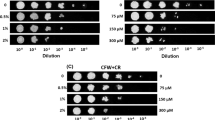Abstract
Breaking of hyphae derived from growth of the phytopathogenic fungus Crinipellis perniciosa in liquid media yielded cell aggregates that performed as “quasi single cell” in toxicity assays. When treated with the chemical mutagens 4-nitroquinoleine-1-oxide (4NQO), hydrogen peroxide (H2O2), or paraquat (PAQ) as well as with ultraviolet light (UVC), broken hyphae of C. perniciosa gave a single cell–like response, i.e., survival curves similar to those obtained when treating single-cell suspensions. C. perniciosa had significantly higher UVC resistance than haploid bakers yeast but was more sensitive to 4NQO and extremely sensitive to PAQ and H2O2 when compared to likewise-treated yeast. Haploid C. perniciosa basidiospores (monokaryotic) were significantly more UVC resistant than C. perniciosa broken hyphae and than haploid and diploid yeast wild-type strains. This suggests a high capacity in C. perniciosa for repair of UVC-induced DNA lesions or, alternatively, an efficient protection from UVC irradiation, especially in basidiospores. The pronounced sensitivity of the dikaryotic form of C. perniciosa to PAQ and H2O2 points to a weak protection from oxidative stress-inducing agents.



Similar content being viewed by others
Literature Cited
Garon D, Krivobok S, Seigle-Murandi F (2000) Fungal degradation of fluorene. Chemosphere 40:91–97
Gesteira A, Micheli F, Ferreira CF, Cascardo JCM (2003) Isolation and purification of functional total RNA from different organs of cacao tree during its interaction with the pathogen Crinipellis perniciosa. Biotechniques 34:494–500
Kagi JHR, Schaffer A (1988) Biochemistry of metallothionein. Biochemistry 27:8509–8515
Kappus H, Sies H (1981) Toxic drug effects associated with oxygen metabolism: Redox cycling and lipid peroxidation. Experientia 37:1233–1241
Lima JO, dos Santos JK, Pereira JF, de Resende MLV, de Araújo EF, de Queiroz MV (2003) Development of a transformation system for Crinipellis perniciosa, the causal agent of witches’ broom in cocoa plants. Curr Genet 42:236–240
Meinhardt L, Bellato C, Rincones J, Azevedo R, Cascardo JCM, Pereira GAG (2006) In vitro production of biotrophic-like cultures of Crinipellis perniciosa, the causal agent of witches’ broom disease of Theobroma cacao. Curr Microbiol (in press)
Nunoshiba T, Demple B (1993) Potent intracellular oxidative stress exerted by the carcinogen 4-nitroquinoline-N-oxide. Cancer Res 53:3250–3252
Pungartnik C, Viau C, Picada J, Caldeira-de-Araújo A, Henriques JAP, Brendel M (2005) Genotoxicity of stannous chloride in yeast and bacteria. Mutat Res 583:146–157
Purdy LH, Trese HT, Aragundi J (1983) Proof of pathogenicity of Crinipellis perniciosa to Theobroma cacao by using basidiospores produced in in vitro culture. Rev Theobroma 13:157–163
Rincones J, Meinhardt LW, Vidal BC, Pereira GA (2003) Electrophoretic karyotype analysis of Crinipellis perniciosa, the causal agent of witches’ broom disease of Theobroma cacao. Mycol Res 107:452–458
Rubini MR, Silva-Ribeiro RT, Pomella AW, Maki CS, Araujo WL, Dos Santos DR, Azevedo JL (2005) Diversity of endophytic fungal community of cacao (Theobroma cacao L.) and biological control of Crinipellis perniciosa, causal agent of Witches’ Broom Disease. Int J Biol Sci 1:24–33
Tada M (1975) Seryl-tRNA synthetase and activation of the carcinogen 4-nitroquinoline-1-oxide. Nature 255:510–512
Thomas DC, Husain I, Chaney SG, Panigrahi GB, Walker IG (1991) Sequence effect on incision by (A)BC excinuclease of 4NQO adducts and UV photoproducts. Nucleic Acids Res 19:365–370
Walters D, Raynor L, Mitchell A, Walker R, Walker K (2004) Antifungal activities of four fatty acids against pathogenic fungi. Mycopathologia 157:87–90
Acknowledgments
Basidiospores were kindly donated by Alan Pomella from Almirante Cacao. Research supported by Fundação de Amparo a Pesquisa do Estado do Bahia (FAPESB) and Conselho Nacional de Desenvolvimento Científico e Tecnológico (CNPq). C.P. holds a CNPq fellowship (PRODOC/FAPESB/CNPq). M.B. is a Visiting Scientist supported by FAPESB.
Author information
Authors and Affiliations
Corresponding author
Rights and permissions
About this article
Cite this article
Filho, D.F., Pungartnik, C., Cascardo, J.C. et al. Broken Hyphae of the Basidiomycete Crinipellis perniciosa Allow Quantitative Assay of Toxicity. Curr Microbiol 52, 407–412 (2006). https://doi.org/10.1007/s00284-005-0405-3
Received:
Accepted:
Published:
Issue Date:
DOI: https://doi.org/10.1007/s00284-005-0405-3




